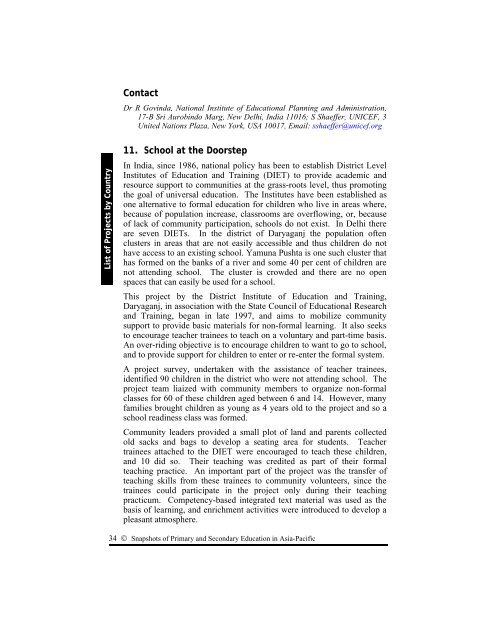Download PDF, 752KB - UNESCO Bangkok
Download PDF, 752KB - UNESCO Bangkok
Download PDF, 752KB - UNESCO Bangkok
Create successful ePaper yourself
Turn your PDF publications into a flip-book with our unique Google optimized e-Paper software.
ContactDr R Govinda, National Institute of Educational Planning and Administration,17-B Sri Aurobindo Marg, New Delhi, India 11016; S Shaeffer, UNICEF, 3United Nations Plaza, New York, USA 10017, Email: sshaeffer@unicef.orgList of Projects by Country11. School at the DoorstepIn India, since 1986, national policy has been to establish District LevelInstitutes of Education and Training (DIET) to provide academic andresource support to communities at the grass-roots level, thus promotingthe goal of universal education. The Institutes have been established asone alternative to formal education for children who live in areas where,because of population increase, classrooms are overflowing, or, becauseof lack of community participation, schools do not exist. In Delhi thereare seven DIETs. In the district of Daryaganj the population oftenclusters in areas that are not easily accessible and thus children do nothave access to an existing school. Yamuna Pushta is one such cluster thathas formed on the banks of a river and some 40 per cent of children arenot attending school. The cluster is crowded and there are no openspaces that can easily be used for a school.This project by the District Institute of Education and Training,Daryaganj, in association with the State Council of Educational Researchand Training, began in late 1997, and aims to mobilize communitysupport to provide basic materials for non-formal learning. It also seeksto encourage teacher trainees to teach on a voluntary and part-time basis.An over-riding objective is to encourage children to want to go to school,and to provide support for children to enter or re-enter the formal system.A project survey, undertaken with the assistance of teacher trainees,identified 90 children in the district who were not attending school. Theproject team liaized with community members to organize non-formalclasses for 60 of these children aged between 6 and 14. However, manyfamilies brought children as young as 4 years old to the project and so aschool readiness class was formed.Community leaders provided a small plot of land and parents collectedold sacks and bags to develop a seating area for students. Teachertrainees attached to the DIET were encouraged to teach these children,and 10 did so. Their teaching was credited as part of their formalteaching practice. An important part of the project was the transfer ofteaching skills from these trainees to community volunteers, since thetrainees could participate in the project only during their teachingpracticum. Competency-based integrated text material was used as thebasis of learning, and enrichment activities were introduced to develop apleasant atmosphere.34 © Snapshots of Primary and Secondary Education in Asia-Pacific
















